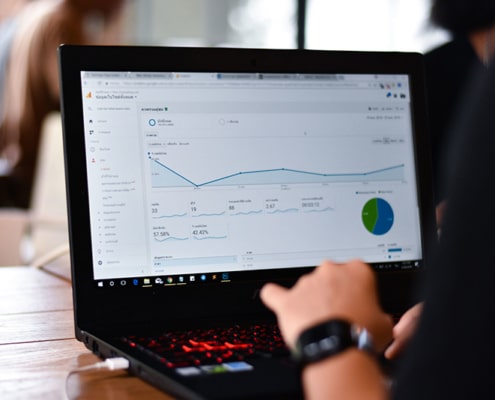The Metrics You Need To Measure Digital Marketing Success
The secret weapon of digital marketing isn’t its ability to reach anyone with a web connection. It’s the ability to measure the behavior of visitors. Good metrics give marketers the tools they need to prove that their marketing is working. And if it isn’t working, it can tell you where the problems are so you can focus on exactly what’s necessary to fix them.
There are dozens of possible metrics depending on what tools you’re using to measure your marketing. In this piece, we’re going to look at the fundamental metrics of digital marketing that you need to know. There are fancier metrics derived from these, but without understanding the basics then more complex measurements are just numbers.
What Are We Measuring, Really?

This sort of measuring is nothing new for the internet. ISPs have been using metrics packages for a long time to bill popular websites for bandwidth and to detect unusual activity. But marketers figured out that these things could be used for more than checking for hackers and pirates.
We’ll get into the details of certain metrics, but the process boils down to this. A metrics package will take your browser data and record your entry to the site. It will watch your behavior on the site in certain ways, like how long you stay on a page or what route you take. Finally, it will detect when you leave the site.
If your metrics package is really fancy (think Facebook), the website might even leave a cookie so that when you come back with that browser it will add on to the data it has already collected from your browser and build a sophisticated profile. This is how things like retargeting work. Metrics like these are beyond the scope of this article, but it shows you the possibilities.
Traffic Metrics
Let’s first look at the metrics that trigger when someone visits your website. These are called traffic metrics. A key thing to know about traffic metrics is that it’s not just people who visit websites. There are a lot of automated programs that also connect with websites. For instance, a search engine might be scanning your site to see if there are any new pages.
Instead of focusing on the number, it’s much better to look at how it trends over time. One day spikes in traffic could be in reaction to something you’ve posted, but it could also just be an unusually heavy day for bot traffic. It’s a signal to dig deeper to find out who is visiting.
Tracking trends goes for all metrics and these trends should be compared with a solid baseline of collected data. If you can wait a month or even three months before you start tracking trends, you’ll have much stronger data to rely on when you start to make changes.
Traffic metrics are divided by where the source came from:

Direct Traffic: While this may seem old-fashioned, some people do type in a URL directly into their browser or use a bookmark. When a browser goes directly to your site like this, rather than through clicking on a link, this is called direct traffic. While these are part of your overall traffic numbers, there is little you can do to increase them.
However, if you can identify users who are visiting your site directly they are likely to be strong leads. They know your site well enough to skip the search engine. Also, if you get a lot of direct traffic to a piece of content on your site then it’s a sign that that piece is particularly useful. People want to save it for later.
Referral Traffic: Referral traffic is traffic that comes from a link on someone else’s site to yours that isn’t a search engine. Let’s say you’ve been guest posting on sites. If you see a bump in referral traffic, that means that the audience for that site liked your article and wants to know more about you. If you see a sudden spike, that’s a good sign that an influencer or some major website has mentioned you. The records of the visits should reveal where the extra traffic originated.
Social Traffic: Social traffic, as the name suggests, is traffic that comes from a social media website. Most metrics packages will break it down by social media channel along with a total. Naturally, if you see a spike in this metric then something is attracting attention on social media.
Mobile Traffic: Knowing how your users are accessing your site can help you made decisions on how to design your pages. Overall mobile traffic continues to increase year over year. If most of the traffic you get is from mobile devices, you can consider making your site from a mobile-centric standpoint. On the other hand, if your mobile traffic is low (or you have a high bounce rate), there could be something about your site that is turning off mobile users.
In addition to these, there is an overall traffic number that combines all of these sources, but the metrics that track per source are much more useful for planning strategy.
Behavior Metrics
Next, let’s look at some metrics that reveal things about user behavior.

Thus, you have to be careful with using bounce rate as a metric. One thing you can do if you know how long your average session duration for a conversion is, you can set up your own metric to track visitors who stay long enough on the page and exclude them from the bounce rate. This is an advanced tactic, but this page will show you how to do it.
Average Session Duration: Each time your visitor hops to a new page, your analytics package will track how long they spent on the previous page. This is calculated into an average. This is also a tricky metric because there can be outliers. If someone visits and then stops interacting with the site for a few hours, you’ll get a big bump in this when they come back and continue.
The purpose of this metric is to show engagement. Ideally, if people are taking longer on a page then they’re taking the time to absorb the content with interest. But there’s no way to prove that. Also, there’s no standard for what is good or bad for a duration. It depends on the content and your audience. Thus, if you feel that tracking this is important you’ll need to track things over time.
Conversion Rate: The most important metric from an ROI standpoint! It is the ratio of visitors to a page to the number that visits and completes an action that you define. This could be a sale, a sign-up, a download, or anything else that you define as a conversion action. The ultimate goal of any digital marketer is to raise this as high as possible without spending so much money that the profit goes down.
A conversion rate for a non-sales action can be considered a lead generation rate. The number of new sign-ups for a mailing list and the ratio of visitors to sign-ups can be used to show the effectiveness of the copy to join that list.
What About ROI, Retention, Etc.?
Managers who aren’t in the thick of digital marketing often want to know a quick ROI or customer retention metric from marketing. Unfortunately, calculating this isn’t nearly as easy as the other metrics. It depends on your unique marketing mix and careful tracking of your spending. Some marketing methods, like content marketing where a visitor might go through multiple content pieces over time before converting, it can be extraordinarily tricky to track.
That doesn’t mean it’s impossible, but marketing and management will have to agree on a set of terms for how to measure these. Even if you use specialized analytics packages that say they can track these, you’ll still need to agree on those terms.
This is just the tip of the iceberg when it comes to metrics, but these are the most important. You need to know where your traffic is coming from so you can see how people are entering your funnel. You need behavior tracking metrics to figure out how people are moving through your funnel (or not). Finally, you can link these metrics with more general business metrics like ROI and customer retention by figuring out a way to measure these that works for all stakeholders.



